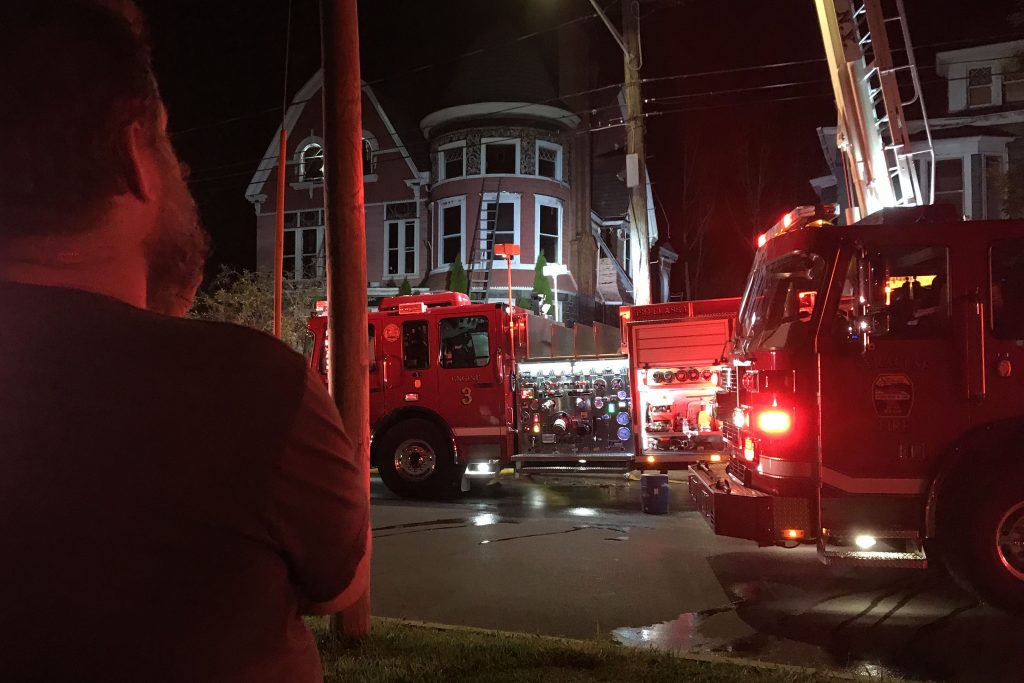Fire at historic Syracuse house leaves neighbors feeling sentimental
Fire rips through historic Syracuse house

Jasiya Dennard always liked the big house near her grandma’s place.
The Victorian-style, two-story house at 749 W. Onondaga St., towered over the newly built Section 8 townhouses nearby and stood out on for its reddish-pink paint.
Dennard can’t remember if she’s ever set foot in the house some called the “Pink Palace,” but sometimes the 7-year-old likes to imagine that she lives there.
“It’s pretty,” she said. “I like pink, and it’s really big.”
On Tuesday evening, Dennard was doing cartwheels with her friends when saw smoke coming out of the windows of the Skunk City neighborhood house.
Dennard called her grandmother who called 911, and soon, dozens of people watched firefighters take on the blaze and smoke billowing from the abandoned house once owned by the area’s wealthiest architect
“It’s what you know from original Syracuse,” neighbor Teresa B. Williams said. “This house means a lot.”
The fire lured dozens of residents from the nearby Christopher Community Inc. townhouses and surrounding streets, standing on a plot of land that used to be wooded. Some watched on with drinks in hand, while others live streamed the moment on Facebook.
Firefighters shattered the glass windows, releasing a billow of dark smoke into the night air. Flashing lights from fire engines lit up the public townhouses along West Onondaga Street, a stretch that residents said was once known as “millionaires way.”
Archimedes Russell, a heralded architect in central New York and former Syracuse University professor, built the house in 1885 for himself to match the Victorian style shared by many houses on West Onondaga Street. While it had fallen into some disrepair in recent years, the house still had the original pillars dividing the walls and the window designs from 135 years ago.
“You got marble stairs right there,” said John Jones Jr., 55.
“The chandeliers in the house are nothing but crystal,” Williams added.
Russell had just finished designing SU’s Hall of Languages and the Onondaga County Courthouse downtown when he moved into the Skunk City house. The city’s longest-serving mayor used to live down the street. L. Frank Baum, the author of Wizard of Oz, met his wife in a now-boarded-up white house a block away.
The inside of Russell’s home had old wooden floors and giant black pillars. “A mansion,” several neighbors called it, and more recently a banker lived there, then it was a border house, and a funeral home. Realtors had recently touted the house as a potential Bed and Breakfast or commercial property.
A developer had recently listed the house with six bedrooms, three bathrooms, a spiral staircase and brick-layered kitchen island for $115,000. There was the same double-door-and-window structure as in 1885, and most rooms still had chandeliers from decades before. But that was more than any buyer would pay to live on West Onondaga Street, so the house sat there, temporarily one of the 2,000 vacant properties across the city.
Housing prices plummeted in the 1970s as manufacturing jobs left Syracuse and the Interstate 81 highway system split the city, sinking home prices and raising poverty levels throughout the city.
Jeff Foley, whose house sits right behind the big pink house, attributed the street’s transformation to these two factors.
Abandoned mansions are scattered across the city, collecting dust as the city’s population underwent a steady decline since the 1950s. But unlike many of them, this house yielded interest from prospective buyers. The Syracuse Land Bank hadn’t yet bought it. Syracuse.com deemed it the “house of the week” in January. Several neighbors said it was recently toured.
On Tuesday, nearby residents stayed by the property for about an hour before heading home around 9:45 p.m.
Foley was one of the last people there and walked over to a few others who stayed behind. He pointed past the fire trucks, past the police cars and over toward the house once more, still in awe of what he was witnessing.
“Those steps are made of marble,” he said.





